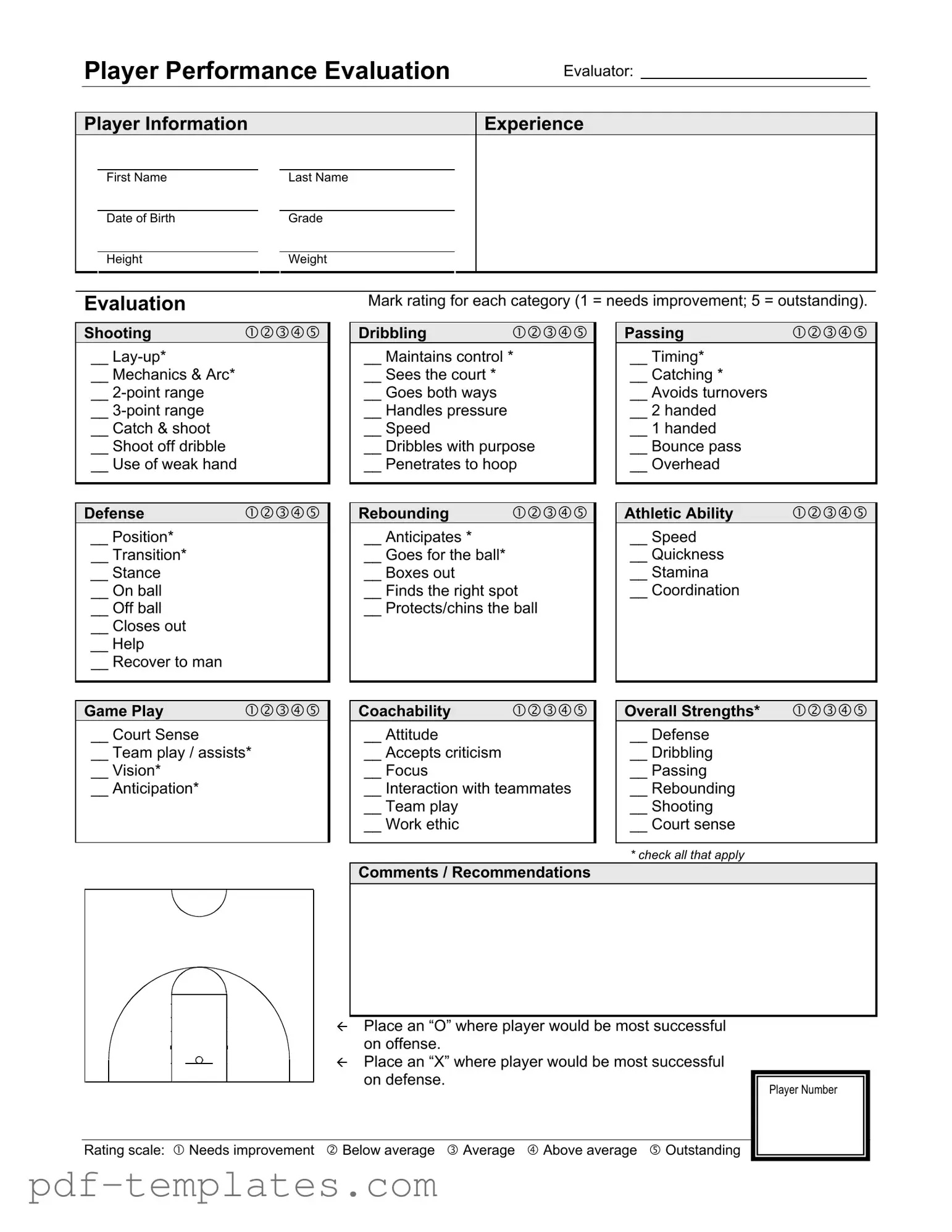The Player Performance Evaluation form shares similarities with the Coach's Assessment form. Both documents focus on evaluating an athlete's skills and performance, allowing coaches to provide structured feedback. The Coach's Assessment form includes categories such as shooting, defense, and overall athletic ability, much like the Basketball Evaluation form. Each section requires a rating system, enabling coaches to identify strengths and areas for improvement in a clear and organized manner.
The Skills Assessment Worksheet is another document akin to the Basketball Evaluation form. This worksheet emphasizes specific skill sets, including dribbling, shooting mechanics, and defensive strategies. Both documents utilize a rating scale to quantify performance, which aids in tracking progress over time. The Skills Assessment Worksheet may also include space for comments, similar to the recommendations section in the Basketball Evaluation form.
In the realm of athletic evaluation, the CA DMV SR1 form serves a distinct purpose much like various assessment tools in sports, as it is a mandatory report for traffic accidents that provides essential details about incidents involving personal injury or significant property damage in California. Just as forms such as the Player Development Plan or the Basketball Evaluation are integral to monitoring growth and performance, completing the All California Forms is crucial in documenting accidents to ensure compliance with state regulations and safeguard driving privileges.
The Player Development Plan aligns closely with the Basketball Evaluation form as well. This plan is designed to outline a player's strengths and weaknesses, much like the evaluation process. Coaches use it to create tailored training programs based on the assessment results. Both documents serve to enhance player development by providing a comprehensive view of performance and potential growth areas.
The Performance Review Template is comparable to the Basketball Evaluation form in that it provides a structured format for evaluating an athlete's performance. This template often includes various categories related to skill sets and overall game play. Like the Basketball Evaluation form, it encourages coaches to provide detailed feedback and recommendations for improvement, fostering a constructive environment for player growth.
The Athletic Performance Tracker is another document that resembles the Basketball Evaluation form. This tracker monitors an athlete's performance metrics over time, including speed, agility, and skill proficiency. Both documents aim to provide a comprehensive overview of an athlete's capabilities, allowing for informed decisions regarding training and competition. The Athletic Performance Tracker often includes visual aids, such as graphs, to illustrate progress, complementing the written evaluations found in the Basketball Evaluation form.
The Game Analysis Report is similar to the Basketball Evaluation form in its focus on assessing player performance during actual games. This report breaks down various aspects of a player's game, such as decision-making, teamwork, and execution of skills. Both documents rely on a systematic approach to evaluation, helping coaches and players understand performance in context. The Game Analysis Report often includes specific game scenarios, providing a practical application of the skills assessed in the Basketball Evaluation form.
The Training Progress Log also shares characteristics with the Basketball Evaluation form. This log tracks an athlete's training sessions, detailing improvements in specific skill areas over time. Like the evaluation form, it emphasizes the importance of consistent assessment and feedback. Coaches can use both documents to set goals and measure progress, ensuring that athletes remain focused on their development.
The Scouting Report is another document that bears similarities to the Basketball Evaluation form. This report provides insights into an athlete's skills and performance, often in the context of competition against others. Both documents aim to evaluate strengths and weaknesses, helping coaches make informed decisions about player development and game strategy. The Scouting Report may also include comparative analysis, which can enhance the insights gained from the Basketball Evaluation form.
Finally, the Player Feedback Form is akin to the Basketball Evaluation form in its purpose of gathering input on a player's performance. This form allows players to reflect on their own skills and areas for improvement, paralleling the structured evaluation provided by coaches. Both documents promote a dialogue between players and coaches, fostering a collaborative approach to development and performance enhancement.
